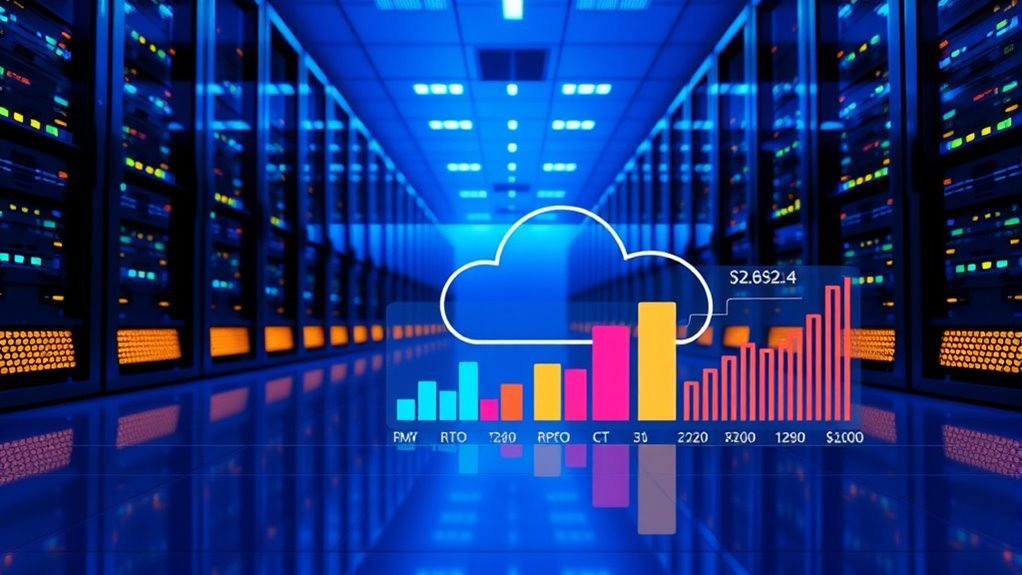Recovery Time Objectives (RTO) and Recovery Point Objectives (RPO) are crucial for cloud environments, as they define the minimum acceptable downtime and data loss for your applications. RTO focuses on how quickly systems should be restored, while RPO evaluates how much data you can afford to lose during an outage. Balancing both metrics is essential for operational efficiency and cost management. By effectively evaluating your needs, you can create robust disaster recovery plans that guarantee continuity. Exploring further can reveal strategies to optimize these objectives.
Understanding RTO and RPO in Cloud Environments
When you're maneuvering the complexities of cloud environments, understanding Recovery Time Objective (RTO) and Recovery Point Objective (RPO) is vital for effective disaster recovery planning. RTO metrics define the maximum acceptable downtime for your systems, while RPO strategies focus on the maximum data loss regarding time. Achieving ideal cloud uptime requires a careful balance between these objectives, factoring in system dependencies and the unique service level agreements (SLAs) you've established. When evaluating risks, it's important to assess downtime predictions that could impact your operations. This analysis informs your data recovery plan, ensuring you can restore services within the desired RTO while minimizing data loss to meet your RPO. By clearly defining these metrics, you empower your organization to remain resilient, maintaining operational continuity even in the face of potential disruptions. Understanding RTO and RPO consequently facilitates informed decision-making and strategic planning in cloud environments.
Importance of RTO and RPO for Cloud-Based Applications
Understanding RTO and RPO is essential for ensuring cloud service resilience and effectively managing costs. By defining these metrics, you can minimize downtime and data loss, which directly impacts your operational efficiency. Additionally, incorporating RTO and RPO into your cloud strategy can optimize resource allocation and enhance overall service reliability.
Cloud Service Resilience
While businesses increasingly migrate to cloud-based applications, the concepts of Recovery Time Objective (RTO) and Recovery Point Objective (RPO) become essential for guaranteeing service resilience. Understanding these metrics enables you to design effective disaster recovery strategies tailored to various cloud service models. Here are four key considerations:
- Service Availability: Determine the maximum acceptable downtime for your applications.
- Data Integrity: Assess how much data loss is tolerable; this informs your RPO.
- Cloud Service Models: Recognize how different models (IaaS, PaaS, SaaS) impact your RTO and RPO.
- Testing and Maintenance: Regularly test your recovery plans to guarantee they meet defined objectives.
Cost Management Strategies
Given the vital nature of RTO and RPO in disaster recovery planning, businesses must integrate these metrics into their cost management strategies for cloud-based applications. Effective cost allocation is essential; you'll want to guarantee that investments align with your RTO and RPO requirements. Implementing robust cloud budgeting practices enables you to forecast and control expenditures, optimizing resource utilization. Prioritizing resource optimization helps maintain operational efficiency while minimizing unnecessary costs. Additionally, expenditure tracking plays an important role in evaluating financial performance against recovery objectives. By aligning these strategies, you not only enhance resilience but also maintain fiscal responsibility, allowing your organization the freedom to adapt and scale as needed in a dynamic cloud environment.
Calculating RTO and RPO for Cloud Services
To effectively calculate RTO and RPO for your cloud services, you need to start by evaluating which systems are critical to your operations. Gauging the value of your data will help determine the acceptable downtime and data loss for each system. An extensive business impact analysis will provide insights into the potential repercussions of disruptions, enabling precise RTO and RPO definitions.
Assessing Critical Systems
When evaluating critical systems in the cloud, understanding Recovery Time Objective (RTO) and Recovery Point Objective (RPO) is essential for ensuring business continuity. To effectively assess the criticality of your systems, you should consider the following:
- Identify Key Systems: Determine which systems are crucial for operations and require prioritization.
- Conduct a Criticality Assessment: Evaluate the impact of system downtime on business processes.
- Define RTO and RPO: Establish acceptable downtime and data loss limits for each critical system.
- Document and Review: Keep records of your assessments and periodically revisit them as business needs evolve.
Evaluating Data Value
Calculating Recovery Time Objective (RTO) and Recovery Point Objective (RPO) for cloud services hinges on the value of the data being handled. You'll need to assess data classification and information sensitivity to identify the business value of each asset. This process informs your risk assessment and helps in prioritizing assets based on operational impact and compliance requirements. Understanding the data lifecycle is essential; different data types necessitate distinct RTO and RPO metrics. For instance, sensitive customer information may require shorter recovery times due to legal obligations, while less critical data can afford longer periods. By aligning RTO and RPO with data value, you guarantee robust recovery strategies tailored to your organization's unique needs.
Business Impact Analysis
A thorough Business Impact Analysis (BIA) is essential for determining accurate Recovery Time Objectives (RTO) and Recovery Point Objectives (RPO) in cloud environments. By evaluating the business impact of potential disruptions, you can prioritize recovery strategies effectively. Here's how to conduct your BIA:
- Identify critical processes: Determine which business functions are essential for operations.
- Evaluate dependencies: Assess the systems and data that support these critical processes.
- Conduct a risk assessment: Analyze potential threats and their likelihood of occurrence.
- Estimate impacts: Quantify the financial and operational consequences of downtime for each process.
This structured approach helps you establish realistic RTOs and RPOs, ensuring your cloud strategy aligns with your business continuity goals.
Implementing RTO and RPO in Disaster Recovery Plans
To effectively implement Recovery Time Objectives (RTO) and Recovery Point Objectives (RPO) in disaster recovery plans, organizations need to align these metrics with their specific business requirements and risk tolerances. This alignment guarantees your cloud strategies can withstand disruptions. Begin by evaluating your critical services and their acceptable downtime, then establish RTO and RPO values accordingly.
Here's a simplified view of RTO and RPO considerations:
| Metric | Definition |
|---|---|
| RTO | Maximum acceptable downtime |
| RPO | Maximum acceptable data loss |
| Strategy | Cloud recovery approach |
Tiering Applications in the Cloud Based on RTO and RPO
While organizations often recognize the importance of RTO and RPO, effectively tiering applications in the cloud based on these metrics is essential for optimizing disaster recovery efforts. By classifying applications according to their criticality, you can guarantee appropriate resource allocation during recovery. Here's a simple framework for tiering:
- Tier 1 (Critical): Applications with low RTO and RPO requirements, needing immediate recovery.
- Tier 2 (Important): Applications with moderate RTOs and RPOs, requiring timely but not immediate recovery.
- Tier 3 (Non-Critical): Applications with high RTOs and RPOs, allowing for extended recovery times.
- Tier 4 (Archival): Applications seldom used, where data preservation is key but recovery isn't urgent.
This application classification not only streamlines your disaster recovery process but also enhances efficiency in resource allocation, guaranteeing you meet your business continuity objectives effectively.
Challenges of Managing RTO and RPO in Cloud Solutions
Managing RTO and RPO in cloud solutions presents several challenges, particularly as organizations scale and diversify their IT environments. One significant hurdle is scalability issues; as your infrastructure grows, maintaining consistent RTO and RPO becomes increasingly complex. The varied nature of cloud resources can lead to discrepancies in performance, making it difficult to guarantee that all components align with your recovery objectives.
Moreover, data synchronization is a critical concern. As data is spread across multiple cloud platforms or regions, achieving real-time synchronization can be problematic. Delays in data replication can result in outdated backups, jeopardizing your RPO. In addition, the dynamic nature of cloud environments means that configurations can change rapidly, complicating recovery strategies. To effectively manage RTO and RPO, you'll need to continuously assess your cloud architecture and implement robust monitoring solutions to address these challenges proactively.
Best Practices for Achieving RTO and RPO in the Cloud
Achieving ideal RTO and RPO in cloud environments requires implementing a set of best practices that address the inherent challenges previously discussed. Here's how you can optimize your strategies:
- Cloud Backup: Guarantee regular and automated backups, tailored to your service level agreements, to minimize data loss risks.
- Data Replication: Use real-time data replication across multiple locations to enhance availability and reduce recovery times.
- Performance Monitoring: Continuously monitor system performance to identify bottlenecks and optimize recovery strategies proactively.
- Disaster Simulations: Regularly conduct disaster simulations and risk assessments to validate your automated recovery processes and compliance requirements.
Frequently Asked Questions
How Do RTO and RPO Differ for On-Premises and Cloud Environments?
When you compare on-premises differences with cloud advantages, you'll find distinct contrasts in how recovery strategies are implemented. On-premises solutions often require more manual intervention, leading to longer recovery times and potential data loss during failures. In contrast, cloud environments can automate backups and facilitate quicker restores, greatly reducing downtime and data risk. This flexibility allows you to tailor your approach, ensuring a more resilient infrastructure that meets your organization's evolving needs.
What Tools Can Help Monitor RTO and RPO in the Cloud?
Like a vigilant lighthouse guiding ships through fog, monitoring tools illuminate the complexities of cloud environments. You'll find cloud analytics platforms invaluable; they track performance metrics, ensuring data integrity and availability. Tools like AWS CloudWatch and Azure Monitor provide real-time insights into your cloud infrastructure, allowing you to swiftly assess system health and pinpoint potential issues. Embracing these technologies grants you the freedom to navigate your cloud landscape with confidence.
Can RTO and RPO Values Change Over Time?
Yes, RTO fluctuations and RPO adjustments can occur over time due to various factors. As your business requirements evolve, so will your data recovery needs. Changes in technology, regulatory compliance, or operational priorities can necessitate a reassessment of these metrics. It's essential to regularly review and update your strategies to guarantee they align with your current objectives, thereby allowing you the freedom to adapt to unforeseen challenges while maintaining data resilience and availability.
How Do Regulatory Requirements Affect RTO and RPO in Cloud Services?
Imagine a fortress, protecting your data against the storms of regulatory requirements. Compliance standards dictate how you must manage your cloud services, ensuring adherence to laws like GDPR or HIPAA. This can shape your RTO and RPO considerably, as you'll need to account for data sovereignty—where your data resides. As regulations evolve, they can impose stricter demands, compelling you to adjust your strategies to maintain both security and freedom in your cloud environment.
What Role Does Data Encryption Play in RTO and RPO?
Data encryption plays an essential role in data security, as it safeguards sensitive information from unauthorized access. By employing advanced encryption techniques, you guarantee that even if data is compromised, it remains unreadable without the decryption key. This not only protects your assets but also influences your strategies for data handling during incidents. When you prioritize encryption, you enhance your overall resilience, enabling quicker recovery and maintaining trust in your operations.



